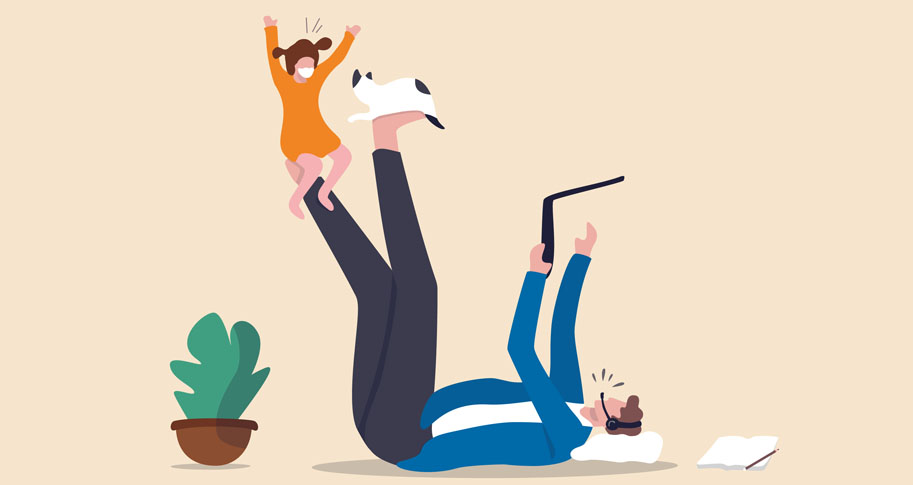
A deluge of data and information—emails, texts, phone calls, and social media posts —floods our workday. Statista projects that 319 billion emails will be sent every single day in 2021, with that rate rising to 376 billion per day by 2025. And that's not counting phone calls, instant messages, texts, or social media posts. Given this deluge, what we don’t get to at work often follows us home. These messages constitute what are called technology-mediated interruptions. They trample all over our days, both at work and at home. They’re the reason Mondays stink so bad and why returning from a vacation sometimes makes us wish we’d never left.
Along with these trends, though, come new capabilities. Instant access to information and media is both a boon and a boondoggle when it comes to work-life conflict (WLC). With so much of our recreational time now involving screens, work and recreation alike are subject to technology-mediated interruptions and their myriad effects.. In the article “Worker stress in the age of mobile technology: The combined effects of perceived interruption overload and worker control,” the authors present their research findings surrounding this work-life stressor.
Stefan Tams, Manju Ahuja, Jason Thatcher, and Varun Grover focus on how these interruptions and overload affect employees when they are taking place after work hours. Interruption overload is essentially self-explanatory: anytime you throw too much information or data at someone, they are not going to remember all of it. Whether they receive the data all at once or in increments , too much is too much, especially given the diversity of its forms: email, text, social media, and so forth. The researchers are asking what happens when those interruptions follow us home. How much control over our own work habits, or even our own lives, are we giving up to these interruptions and how does this affect our work habits?
The Interrupting Digital Landscape
Phone calls have become a generational thing. Our grandparents still had “land lines,” and they wouldn’t pick up the phone if you called during dinner time. It was quite easy to avoid telecommunications if you wanted. But then came the cell phone and soon our parents “had to take this” call during dinner, and you would hear them in the other room talking to co-workers till 9:00 or 10:00 pm. And in today’s world, parents’ biggest concern is how much “screen time” their kids have each day.
Email is no less ubiquitous. Almost 320 billion emails are exchanged every day. The researchers cite a study revealing that the average person checks their smartphone 110 times a day. A Kaiser Family Foundation study showed that children 8-18 spend an average of 7.5 hours in front of screens, over half of which are spent watching videos. That amounts to 114 days a year teenagers spend with screens. Spending almost half your day and a third of the year on the internet could well create habits that might eventually translate into workplace habits.
Mediation Between Work and Home
One downside to having instant access to all things digital is that digital things have no concept of or respect for time of day. Email distractions can affect workplace performance. It takes a couple of minutes to read and answer an email. However, it can also take a couple of minutes for your brain to shift back to the task at hand before you were interrupted. So, the interruptions are not just inconvenient, they take a toll on your mental faculties as you work. For anyone who had to work remotely with kids in the house, this phenomenon will not be surprising, as you likely remember trying to get things done with kids routinely interrupting you.
In another Insights article we covered prosocial behaviors, citizenship, and teamwork in the workplace. The infectiousness of attitudes was a major component in the prosocial and normative behaviors in the workplace. Co-workers on group or team assignments value reciprocity, meaning that you support teammates as much as they have/will support you. This also factors into how we communicate and set goals. If the norm is that we send emails and update each other continuously throughout the day, then technology is going to rule over you to some extent. If people on your team get annoyed when they get emails after 5:00pm, then that may become the norm as well.
“Mediated” technology is a good term to use for this dynamic. While we may not be able to stop the message from being sent to our phone, we do not have to interact with it. Those learned behavior patterns from our youth may be resurfacing. The researchers cited another study that found that 75% of users unlock and interact with their phones between the peak hours of 5:00-8:00pm. Where home life is concerned, you may be dealing with a phone that keeps lighting up or vibrating while you are trying to sleep or wondering whether you should turn on “Do Not Disturb.”
Work Life Conflict Questions
Most employed adults have a pretty good understanding of the complexities of the work-life balance. We may not have figured out the equation yet, but we know it is a very hard math problem. Somewhere between the invention of the “beeper” to smart glasses, the line between work and our homelife disappeared. Work Life Conflict (WLC) primarily comes down to whether we have the agency to dictate our work hours and how they are conducted. Ask yourself, how much power do you feel like you have to mediate your work habits regarding technology?
The researchers look at two theoretical models, the strain and buffer hypotheses, to explain this relationship between work and home life. The strain hypothesis is basically that all the constraints and demands of the workday influence employee behavior. So, if you are a new manager and your boss is sending you emails with questions at 9:00pm, the strain hypothesis accounts for the fact that you cannot demand that your boss leave you alone. In this case the constraints of work directly impact your home life. The buffer hypothesis accounts for active “mediation” taking place between us and technology-mediated interruptions. Essentially, exercising control over the flow of information throughout the day can reduce the strain. Maybe you cannot tell your boss to stop emailing you at 9:00pm, but do you have enough control over your work habits to turn off your push notifications so that you don’t even notice them until the next day?
When we talk about information overload and technology-mediated interruptions, we are negotiating our workplace behaviors. Too much strain and our performance drops and we may burn out. Interruptions and having to negotiate them can cause an employee to procrastinate and avoid the interruption altogether. Having control over the interruptions could mitigate some of the impact this has on our home life. However, for the employer, the use of information technology is seen as a desired behavior or even a requirement in the workplace. When we mediate our work-life balance with our phones and tablets, we are also negotiating with our bosses and/or other employees, which raises the question of just how much of a technology buffer we have between work and home.
Implications for Managers
Keep in mind the adage your writing teachers tried to get you to remember: there is always somebody on the other side of that screen you are typing on. Every writer should know their audience and write accordingly. In terms of the technology-mediated interruptions, the same may also be true. Without actual protocols or rules in place, employees are likely to carry those interruptions home with them, which results in strain. Maybe you can say “not right now” to some emails, but not to the ones from your boss or certain clients.
Arianna Huffington made waves when she began some of the first rallying cries against technology-mediated interruptions. One of Huffington’s bold moves is that they delete any emails an employee receives while on vacation. Their employees thus do not have to dread the email overload that awaits them when they return. They have also implemented protocols to afford employees more control over their email hours, a buffer. But what about when technological habits employed by other employees may be dictating our own habits to some extent. We don’t always have a choice in whether our boss sends us 10 or 100 emails a day; we still have to read and respond to them and mediate our schedule accordingly.
Managers, themselves, though, can do a lot to help alleviate this strain and provide some buffer for the employee by giving them control over their daily IT needs. For example, one of the more common things we see now is email signatures explaining when a person will read and respond to emails. Of course, the challenge then becomes whether you can stand to put your phone in a drawer for two hours while you try to work on other things. Again, email interruptions can take you away from the task at hand for up to 3 or 4 minutes. So, how are you going to balance that while you are helping the kids with their homework, working on a big project with a tight deadline, or, even more importantly, on vacation? Having a plan in place now will make sure that when the interruptions occur, you’ll be able to handle them effectively.







